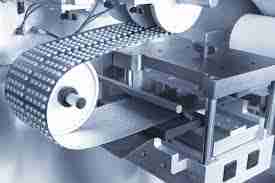Blister packaging has become an essential component of modern packaging solutions across various industries due to its durability, protection capabilities, and cost-effectiveness. It refers to a type of packaging where a product is secured between a pre-formed plastic cavity and a backing material such as aluminum foil, paperboard, or plastic film. With increasing demand from the pharmaceutical, consumer goods, food, and electronics industries, the blister packaging market is poised for significant growth. This article provides an in-depth overview of the blister packaging market, including its structure, key drivers, challenges, and future prospects.

What Is Blister Packaging?
Blister packaging is a form of unit-dose packaging that encloses products in a cavity made from a formable web, usually a thermoformed plastic. The backing, which seals the product in place, is often heat-sealed aluminum foil or plastic film. It is widely used because it offers product protection, visibility, tamper evidence, and shelf-life extension. The design is especially popular for small consumer goods, pharmaceuticals, and food items.
Market Size and Growth
The global blister packaging market has witnessed steady growth in recent years. As of recent industry estimates, the market was valued at approximately USD 25–30 billion and is projected to grow at a compound annual growth rate (CAGR) of around 6% to 8% between 2024 and 2030. This expansion is fueled by increasing demand from the healthcare sector, the rise in over-the-counter (OTC) medication consumption, and the rapid growth of e-commerce and consumer awareness about product safety.
Key Market Drivers
1. Pharmaceutical Industry Demand
The pharmaceutical sector is the largest consumer of blister packaging. These packages provide essential benefits like precise dosage control, extended shelf life, and tamper-evident seals, all critical in medical applications. As global populations age and the prevalence of chronic diseases increases, the demand for safe and reliable packaging for pills and capsules continues to rise.
2. Consumer Convenience and Visibility
Blister packaging allows consumers to see the product without opening it, which builds trust and aids in purchase decisions. Its lightweight and compact design also make it easy to store, open, and transport, which appeals to the on-the-go lifestyles of modern consumers.
3. Cost-Effective and Efficient
Blister packs use less material than traditional rigid packaging and are easier to mass-produce using automated machinery, making them more cost-effective for manufacturers. Their space-efficient nature also reduces shipping and storage costs.
Market Segmentation
The blister packaging market can be segmented based on material, technology, end-user, and geography.
By Material: Common materials include PVC (polyvinyl chloride), PET (polyethylene terephthalate), aluminum, and paperboard. Sustainable alternatives like biodegradable plastics and recyclable materials are becoming increasingly popular.
By Technology: There are two primary types—thermoforming and cold forming. Thermoforming is more common due to its cost-efficiency and transparency, while cold forming provides enhanced protection against moisture and light.
By End-Use: Key end-use industries include pharmaceuticals, food, consumer goods, and electronics.
Regional Insights
North America: Dominated by the pharmaceutical sector, with the United States being a major contributor due to high drug consumption and strict regulatory requirements.
Europe: Strong focus on sustainability and recycling, with advanced blister packaging technologies and growing demand for eco-friendly solutions.
Asia-Pacific: Rapid growth fueled by expanding healthcare infrastructure, rising disposable incomes, and increasing demand for consumer electronics and packaged food in countries like China, India, and Japan.
Latin America & MEA: Emerging markets with potential for future growth, driven by urbanization and expanding healthcare services.
Challenges Facing the Market
Despite its advantages, the blister packaging market faces several challenges:
Environmental Impact: Traditional blister packaging often involves non-recyclable materials like PVC, contributing to plastic waste. This has led to increased pressure from consumers and regulators for sustainable alternatives.
Regulatory Compliance: Meeting the diverse packaging regulations across different countries, especially in pharmaceuticals, can be complex and costly for manufacturers.
High Initial Investment: Setting up automated blister packaging lines requires substantial upfront capital, which may deter small and mid-sized manufacturers.
Emerging Trends
Several trends are shaping the future of blister packaging:
Sustainability: Development of recyclable and biodegradable blister materials is gaining traction. Paper-based blisters and mono-material packaging are becoming popular.
Smart Packaging: Integration of technologies like QR codes, RFID, and NFC for product tracking, anti-counterfeiting, and consumer engagement.
Customization: As consumers seek personalized products, packaging is being customized to meet specific demographic and product needs.
E-commerce Adaptability: Blister packs are being redesigned to suit the needs of e-commerce logistics, with a focus on durability and tamper-evidence during delivery.
Competitive Landscape
The blister packaging market features a mix of global and regional players. Key companies include Amcor plc, WestRock Company, Sonoco Products Company, Constantia Flexibles, Klöckner Pentaplast, and Tekni-Plex. These companies are focusing on innovation, mergers, acquisitions, and expansion into emerging markets to strengthen their positions.
Conclusion
Blister packaging plays a critical role in modern packaging solutions, offering a balance of safety, functionality, and cost-efficiency. With robust demand from the pharmaceutical and consumer goods sectors, coupled with technological advancements and a push toward sustainability, the blister packaging market is expected to witness substantial growth. Companies that adapt to emerging trends and invest in eco-friendly innovations will be well-positioned to lead the market in the years ahead.



